JAKARTA - The word "Mataram" is definitely no stranger to the ears of the Indonesian people. This is the name of a government that was once successful in Java. The relics are also very famous, one of them is the Borobudur temple. Yes, the name of the kingdom is Mataram Kuno (Ancient Mataram).
The location is in the central part of Java Island (Central Java today). The center of the kingdom of Mataram Kuno is called Bhumi Mataram. The ancient Mataram kingdom is surrounded by many mountains and hills, such as Mount Sindoro, Mount Sumbing, Mount Tangkuban Perahu, Mount Merapi, Mount Merbabu, Mount Lawu, and Mount Sewu.
In addition, there are many rivers that flow in the territory of the ancient Mataram kingdom, such as the Progo River, the Elo River, the Bogowonto River, and the Bengawan Solo River. This geographical combination makes the ancient Mataram region very fertile. Here is a more in-depth explanation of one of the kingdoms that are part of the Nusantara history.
Some Historical Sources of the Ancient Mataram Kingdom
There are two main types of historical sources of the ancient Mataram kingdom, namely inscriptions and temples. These two types of historical relics form the basis for finding out the story and intricacies of the government. Here are some inscriptions that tell the story of the ancient Mataram kingdom.
1. Canggal
This inscription is numbered 654 Saka or 732 AD. The Canggal inscription was found in the courtyard of Gunung Wukir Temple, precisely in Canggal Hamlet, Kadiluwih Village, Salam District, Magelang Regency, Central Java Province.
The letters used in the Canggal inscription are palawa, while the language is Sanskrit. The Canggal inscription is the first inscription issued by King Sanjaya in order to commemorate the construction of the phallus on Sthirangga Hill.
The phallus was built as a token of gratitude that he had been able to rebuild the kingdom and reign safely and peacefully after defeating his enemies.
In the inscription, Sanjaya does not mention the name of the kingdom he led. He instead explained that the taste in Java before him was Sanna. After Sanna died, the situation became chaotic, then Sanjaya became king with the help of his mother, Sannaha, who was none other than Sanna's sister.
2. Kalasan
As the name suggests, this numerical inscription of 778M was found in Kalasan Village, Special Region of Yogyakarta (DIY). The letters used in the writing of this inscription are pranagari (North India), while the language is Sanskrit.
This inscription tells of the construction of a sacred building for Goddess Tara and the construction of a monastery for priests by King Panangkaran at the request of the Syailendra family. Panangkaran also presents Kalasan Village to the sangha.
3. Mantyasih
The inscription found in Mantyasih — currently Meteseh, Magelang, Central Java — dates from 907 AD. The language used in the Mantyasih inscription is Ancient Javanese.
This inscription contains the genealogy of the kings of Mataram before Rakai Watukura Dyah Balitung, namely King Sanjaya, Rakai Panangkaran, Rakai Panunggalan, Rakai Warak, Rakai Garung, Rakai Pikatan, Rakai Kayuwangi, and Rakai Watuhumalang.
The ancient Mataram kingdom left many inscriptions. However, some of these inscriptions are inscriptions that are often used to study the ancient Mataram kingdom.
Another source of history is the temple and the kingdom of Ancient Mataram is a kingdom that left many temples, both Hindu and Buddhist. Here are some of the temples: Plaosan temple, Prambanan temple, Sewu temple, Kalasan temple, Kedulan temple, Morangan temple, Ijo temple, Mendut temple, Pawon temple, Sambisari temple, Sari temple, Barong temple, Sojiwan temple, and Borobudur temple.
History of the Ancient Mataram Kingdom and the Change of its Power
Another name from the ancient Mataram kingdom is Medang. This kingdom was once ruled by three dynasties (dynasties), namely the Sanjaya dynasty, the Syailendra dynasty, and the Isyana dynasty.
Wangsa Sanjaya is the founder of this kingdom. They are Shiva Hindus. The Syailendra dynasty was a Buddhist. The Isyana dynasty is a new dynasty founded by Mpu Sindok.
The first king who was also the founder of the ancient Mataram kingdom was Sanjaya. After Sanjaya died, the throne fell to Rakai Panangkaran who embraced Mahayana Buddhism. This was the beginning of the change of dynasty from Sanjaya to Syailendra.
Although its rulers had turned into Buddhists, Hinduism continued to flourish in the Ancient Mataram Kingdom. Hindus are in north-central Java, while Buddhists are in south-central Java.
The Sanjaya dynasty returned to power in the ancient Mataram kingdom after the son of King Samaratungga, namely Pramodawardhani, married Rakai Pikatan who was a Hindu. In other words, the marker of the return of the Sanjaya dynasty to the throne of Ancient Mataram is the appointment of Rakai Pikatan as a king.
At that time, Rakai Pikatan also got rid of Balaputradewa who was the sister of Pramodawardhani (Syailendra dynasty). Balaputradewa fled to the Sriwijaya kingdom in Sumatra. There, Balaputradewa became a king.
The end of the reign of the Sanjaya dynasty in Ancient Mataram was the leadership of Rakai Sumba Dyah Wawa. Mpu Sindok ascended the throne to replace Rakai Sumba Dyah Wawa, then moved the center of the kingdom to eastern Java. Mpu Sindok then built a new dynasty called Isyana.
Location of The Ancient Mataram Kingdom
The center of government of the ancient Mataram kingdom had moved several times. In the early days of its establishment, the center of the ancient Mataram kingdom is estimated to be around or in the region of Mataram (present-day Yogyakarta).
When Rakai Pikatan led Mataram Kuno, the center of the kingdom moved to Mamrati (Kedu district, Central Java). The center of government moved again during the time of Dyah Balitung, namely in Poh Pitu (still Kedu area).
At the time of Dyah Wawa, it is estimated that the center of the kingdom returned to Mataram or Yogyakarta. When the Isyana dynasty sat on the throne, the center of the kingdom moved to eastern Java (present-day East Java).
The Lineage of the King of the Ancient Mataram Kingdom or Medang
Power in Ancient Mataram was once held by three dynasties. Then, who were the kings who led? Here are the kings of the ancient Mataram kingdom from beginning to end.
1. Sanjaya (founder of the ancient Mataram kingdom as well as the Sanjaya dynasty)
2. Rakai Panangkaran (early rule of the Syailendra dynasty)
3. Rakai Panunggalan alias Dharanindra
4. Rakai Warak alias Samaragrawira
5. Rakai Garung alias Samaratungga
6. Rakai Pikatan (the return of Wangsa Sanjaya)
7. Rakai Kayuwangi or Dyah Lokapala
8. Rakai Watuhumalang
9. Rakai Watukura Dyah Balitung
10. Mpu Daksa
11. Rakai Layang Dyah Tulodong
12. Rakai Sumba Dyah Wawa
13. Mpu Sindok (founder of the Isyana dynasty as well as the beginning of the ancient Mataram period in East Java)
14. Sri Lokapala
15. Makuthawangsawardhana
16. Dharmawangsa Teguh (end of the Ancient Mataram Kingdom)
In addition to the historical sources of the ancient Mataram kingdom or Medang, follow other local and foreign news only at VOI.id, Time to Revolutionize the News!
The English, Chinese, Japanese, Arabic, and French versions are automatically generated by the AI. So there may still be inaccuracies in translating, please always see Indonesian as our main language. (system supported by DigitalSiber.id)









